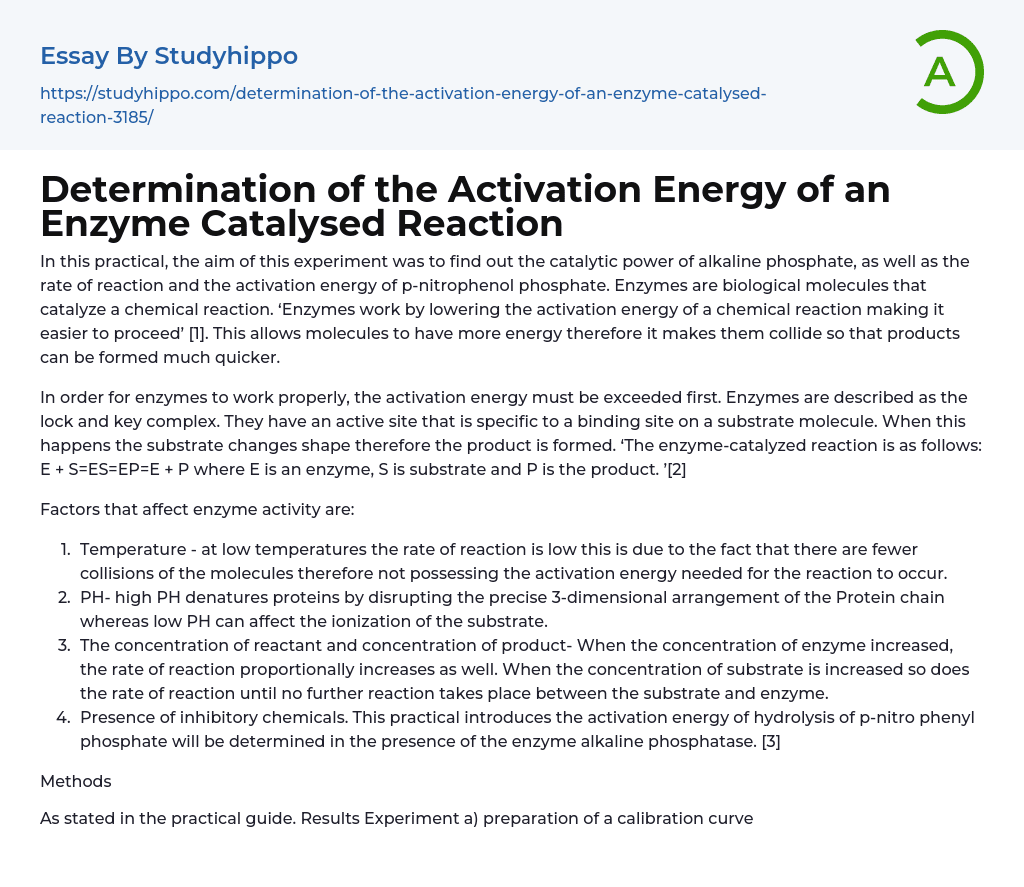

Determination of the Activation Energy of an Enzyme Catalysed Reaction Essay Example
In this practical, the aim of this experiment was to find out the catalytic power of alkaline phosphate, as well as the rate of reaction and the activation energy of p-nitrophenol phosphate. Enzymes are biological molecules that catalyze a chemical reaction. ‘Enzymes work by lowering the activation energy of a chemical reaction making it easier to proceed’ [1]. This allows molecules to have more energy therefore it makes them collide so that products can be formed much quicker.
In order for enzymes to work properly, the activation energy must be exceeded first. Enzymes are described as the lock and key complex. They have an active site that is specific to a binding site on a substrate molecule. When this happens the substrate changes shape therefore the product is formed. ‘The enzyme-catalyzed reaction is as follows: E + S=ES=EP=E + P where E is an enzyme, S is substra
...te and P is the product. ’[2]
Factors that affect enzyme activity are:
- Temperature - at low temperatures the rate of reaction is low this is due to the fact that there are fewer collisions of the molecules therefore not possessing the activation energy needed for the reaction to occur.
- PH- high PH denatures proteins by disrupting the precise 3-dimensional arrangement of the Protein chain whereas low PH can affect the ionization of the substrate.
- The concentration of reactant and concentration of product- When the concentration of enzyme increased, the rate of reaction proportionally increases as well. When the concentration of substrate is increased so does the rate of reaction until no further reaction takes place between the substrate and enzyme.
- Presence of inhibitory chemicals. This practical introduces the activation
energy of hydrolysis of p-nitro phenyl phosphate will be determined in the presence of the enzyme alkaline phosphatase. [3]
Methods
As stated in the practical guide. Results Experiment a) preparation of a calibration curve
- Energy Development essays
- The elements essays
- Voltage essays
- Solar Energy essays
- Nuclear Energy essays
- Alternative Energy essays
- Acid essays
- Calcium essays
- Carbohydrate essays
- Carbon essays
- Chemical Bond essays
- Chemical Reaction essays
- Chemical reactions essays
- Chromatography essays
- Concentration essays
- Copper essays
- Diffusion essays
- Ethanol essays
- Hydrogen essays
- Organic Chemistry essays
- Osmosis essays
- Periodic Table essays
- Ph essays
- Salt essays
- Sodium essays
- Titration essays
- Atom essays
- Big Bang Theory essays
- Density essays
- Electricity essays
- Energy essays
- Force essays
- Heat essays
- Light essays
- Motion essays
- Nuclear Power essays
- Physiology essays
- Sound essays
- Speed essays
- Temperature essays
- Thermodynamics essays
- Bacteria essays
- Biotechnology essays
- Breeding essays
- Cell essays
- Cell Membrane essays
- Cystic Fibrosis essays
- Enzyme essays
- Human essays
- Microbiology essays



